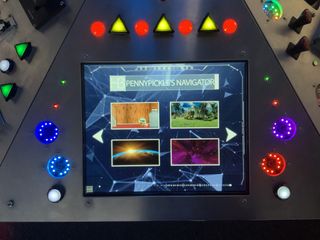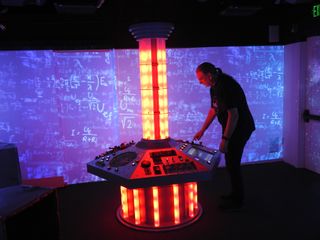The Temecula Children’s Museum, better known as Professor Pennypickle’s Workshop, is the home of Professor Pennypickle, a fictional character who counts luminaries like Nikola Tesla, Thomas Edison, and Sherlock Holmes among her closest friends. In late 2018, the museum was ready to replace one of its exhibits—the basement of the Professor’s Workshop was set up as a recycling lab, but, with new developments, the staff wanted to do something different. They called on Orange, CA-based Mad Systems.
The space in the venue is unique for sure. There are two crawlway entries into the basement: one from the main corridor and one through a chimney from an adjacent room. There is also a “secret entrance” in the form of a door for grown-ups who don’t feel like getting down on their hands and knees.
“Pennypickle’s home being what it is, we clearly needed a very special new exhibit that would provide the right kind of functionality for visitors of all ages, from very young kids right up to teenagers,” said Maris Ensing, founder, Mad Systems. “We also needed to be aware of the possibility for expansion into an escape room type space or something that would allow the staff to entertain corporate groups in the future.”
[High Tech Storytelling: Museums, Exhibits, and AV]
The new basement exhibit is based around a device the museum calls SATTA, the Space and Time Travel Apparatus. Keeping in line with the workshop’s funky themes, the exhibit would require an oddly-shaped console to accommodate Professor Pennypickle’s traveling plans, which involved various times and locations on Earth and in space.
At the center of the design is Mad’s trademarked QuickSilver/TeaParty AV system, which is a new way of designing and building audiovisual systems with elements such as a PC-based control system, a micro-miniature Wi-Fi-controllable media server, and a mesh-based wireless power control network.

Visitors engage with a touchscreen that allows them to select their destination and method of travel for the time/space journey. During travel, one Casio XJ-V2 DLP projector creates a “viewport” on the ceiling, while another, aimed at the floor, creates an “infinite wormhole” that simulates travel in time or space. The projectors are switched on by two Wi-Fi-controlled QuickSilver video servers, and TeaParty controls and varies the scenarios.
An immersive 8-channel audio reply device, which is part of Mad’s QuickSilver AV system, provides the main audio via four RC55i Polk Audio speakers. The system generates a spatial-sound environment that “swirls around visitors during the SATTA take-offs and landings,” according to Ensing.
[5 Ways 5G Could Impact Museums]
“After every trip—which tend to be around 30 seconds or so—the SATTA returns to Professor Pennypickle’s basement,” said Ensing. “Translations to new locations are done via one of a number of transitionals, which are videos that, with the take-off and landing noises, create the actual traveling experience. These transitionals range from fields of complex calculus flying around to beautiful swirls and wormhole type imagery.”

Eight Epson LS100 ultra-short throw projectors immerse visitors in the details of their destinations—from space travel to a visit to the 1800s to experiencing the future in the 2100s.
Audio from the various sources is mixed in a Behringer X32 rackmount audio device and fed into a QSC CX168 8-channel amp to speakers set up in the corners of the room to create a surround audio experience. A self-powered bass speaker is fed with the mixed and filtered output of the eight main audio channels.
“We are delighted to report that feedback to date indicates that a number of visitors have already re-visited the Professor’s home in the weeks since opening,” concluded Ensing. “Visitors wanted to experience the powerful machine known as the SATTA again, which allows them to travel our world, time, and even space without ever having to leave the museum.”












